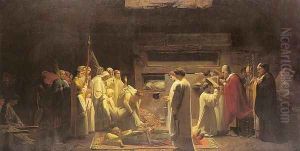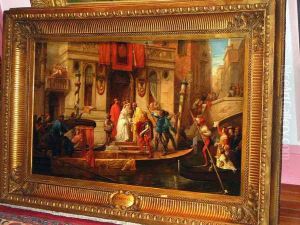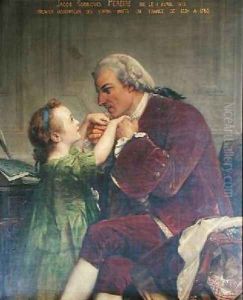Jules-Eugene Lenepveu Paintings
Jules-Eugène Lenepveu was a French painter born on May 16, 1819, in Angers, France. He was recognized for his historical and religious paintings. Lenepveu studied at the École des Beaux-Arts in Paris and was a pupil of the renowned French classicist painter Jean-Auguste-Dominique Ingres. Influenced by his teacher's emphasis on precise drawing and clear forms, Lenepveu developed a style that fused neoclassical clarity with Romantic sensibility.
After completing his education, Lenepveu competed for the prestigious Prix de Rome, a scholarship for art students to study at the French Academy in Rome. He won the prize in 1843 with his painting 'The Death of Priam.' This achievement allowed him to travel to Italy, where he was deeply influenced by the art of the Renaissance and the masterpieces of antiquity. He lived in Rome from 1844 to 1847, a period during which he honed his skills and absorbed the Italianate style that would characterize his later works.
Upon his return to France, Lenepveu received numerous commissions for large-scale decorative works in public buildings. Among his significant projects were murals for the Panthéon in Paris, depicting the life of Saint Genevieve, and for the Palais de Justice in Paris. He also worked on the decoration of the Hotel de Ville and the Sorbonne's amphitheater. Lenepveu's ability to handle monumental compositions made him a sought-after artist for such projects.
Lenepveu's work was marked by a dramatic use of color, a strong sense of composition, and a focus on historical and religious themes. He was part of the academic tradition that dominated French art during the 19th century, but his works also reflect a Romantic interest in emotion and grandeur. Throughout his career, he exhibited at the Paris Salon, where he received several medals for his work, including a first-class medal in 1855.
In addition to his decorative projects, Lenepveu also painted portraits and designed a set of windows for the cathedral of his hometown, Angers. His influence extended beyond his own works, as he also served as a professor at the École des Beaux-Arts in Paris, where he taught many students who would go on to have their own successful artistic careers.
Jules-Eugène Lenepveu passed away on October 16, 1898, in Paris. His legacy is preserved in the many public works he left behind, as well as in the artistic principles he imparted to his students. Despite being less well-known today, his contributions to 19th-century French art are still recognized by art historians and scholars.



